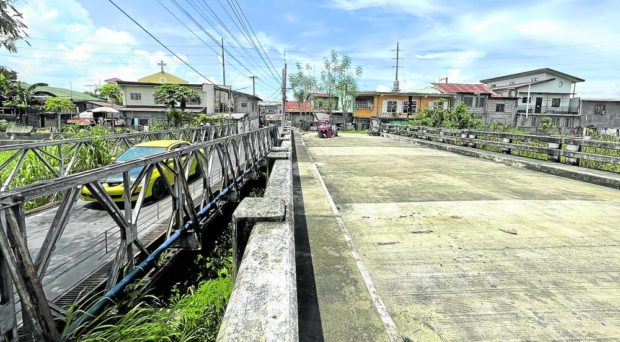
FINISHED YET IDLED | The San Jose Panlumacan Bridge (right) in Barangay San Jose in the City of San Fernando, Pampanga, remains unused despite its completion in April 2016 because two houses are still standing in its path, in this photo taken on Aug. 30. As a result, vehicles and pedestrians continue to use an older, narrower steel bridge (left) that is already deemed risky. —(Photo by TONETTE OREJAS / Inquirer Central Luzon)
CITY OF SAN FERNANDO, Pampanga, Philippines — “Ing tete ali midadalanan (a bridge that is not passable).”
That is how people living near the new San Jose Panlumacan Bridge over the San Fernando River in this city described the project — all because two houses have been blocking its path.
Worse, now that their in-person classes have resumed, students from the University of the Assumption (UA) are being forced to take another, older steel bridge that is still in use next to the new span.
The older bridge creaks under the weight of the daily vehicular traffic, endangering the students and other pedestrians, the residents said.
The new bridge connects roads that lead to villages in San Fernando and Mexico town. Costing P25 million to build, the 27-meter-long structure was completed on April 4, 2016, according to records of the Department of Public Works and Highways (DPWH).
But it remained closed to traffic due to the two houses still standing in its path. Their lot owners refused to budge and accept compensation as they continued to contest the zonal valuation by the Bureau of Internal Revenue (BIR) or the appraisal made by a government bank.
Process followed
Documents obtained by the Inquirer showed that the courts had already favored the DPWH in the expropriation cases filed regarding the properties.
Branches 43 and 44 of the San Fernando Regional Trial Court issued writs of possession in 2019, notices to vacate in 2020 and writs of demolition in February this year, but the right-of-way (ROW) problem remains unresolved to this day.
“We went through the proper expropriation process,” said Isabelita Manalo, deputy chief of the then Mount Pinatubo Emergency Project Management Office, referring to the procedures set by Republic Act No. 10752, or the 2016 law facilitating the acquisition of ROW for public infrastructure projects.
Manalo said there were originally three private property owners who must give way to the bridge project. The first case was already resolved when the owner agreed to be paid P1.9 million for a 320-square-meter lot at P5,000 per sq m, the value determined by the Land Bank of the Philippines (LBP).
P2 million, not P665,000
But another owner, Ruperto Flores, whose 45-sq-m lot was expropriated, rejected the zonal value of P670,390 and demanded a higher compensation during a recent out-of-court negotiation, Manalo said.
Flores, a funeral home owner, could not be immediately contacted by the Inquirer for an interview on Tuesday.
Lawrence Simeon, another lot owner who refused to yield, said he was asking for P2 million for his lot measuring 119 sq m, which the BIR and LBP assessed to be worth only P665,860.
He needed that much because he had to relocate, buy another house and share the proceeds with his siblings, Simeon told the Inquirer.
Dialogues
“[T]he court will have to decide on their new demands,” Manalo said.
Fr. Joselito Henson, the UA president, said the school had initiated dialogues with the lot owners and city officials since 2018 in the hope that the bridge would be opened soon for the safety of UA students and the general public. The first Catholic archdiocesan university in the Philippines and in Asia, the UA has more than 6,000 enrollees this year.
But the ROW problem could not have happened in the first place if the spaces supposedly making up the easement of the San Fernando River had not been occupied or titled at all, Manalo explained.
Article 51 of Presidential Decree No. 1067, or the Water Code of 1976, set aside an easement three meters wide along the banks of rivers in urban areas. These spaces should remain unobstructed for “public use in the interest of recreation, navigation, floatage, fishing and salvage.”
“No person shall be allowed to stay in this zone longer than what is necessary for recreation, navigation, floatage, fishing or salvage or to build structures of any kind,” according to the law.
RELATED STORIES
Pampanga bridge delayed due to “technical issues,” says contractor
A bridge too late: How to delay a gov’t infra project
People from walks of life share bridge woes